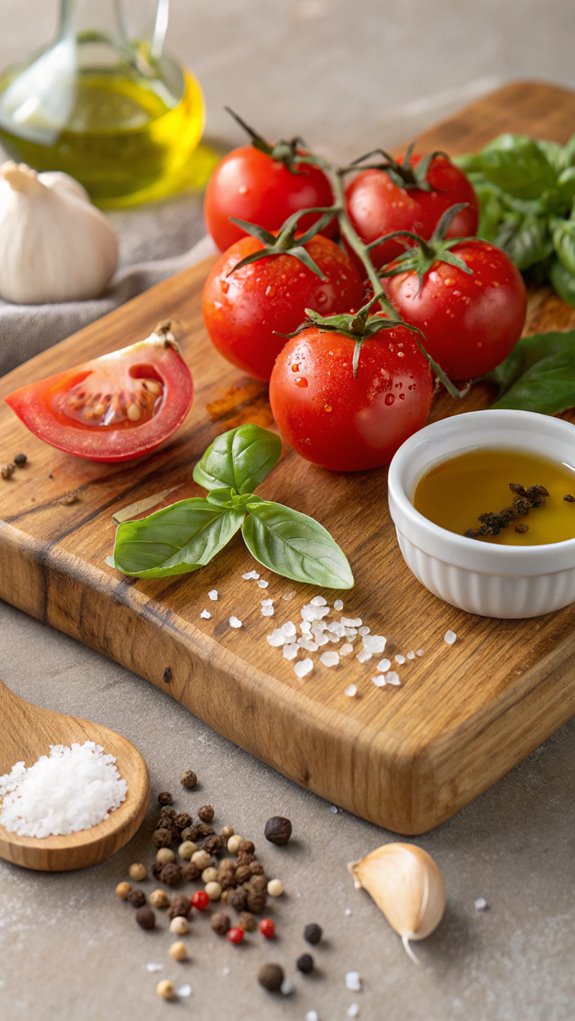Italian Sauce Recipe
To make an authentic Italian sauce, start with high-quality canned San Marzano tomatoes and sauté minced garlic in extra virgin olive oil. Add chopped onions and carrots, then stir in the tomatoes. Bring it to a boil, then simmer. Finish with fresh basil and oregano, adding salt and pepper to taste. Combine cooked pasta with the sauce, using pasta water to adjust the consistency. This simple recipe can be adjusted for flavor, and you can explore more tips on variations.
Why You’ll Love this Recipe
When you try this Italian sauce recipe, you’ll discover a dish that’s not only delicious but also packed with health benefits.
Here are a few reasons you’ll love it:
-
Heart Health: The tomatoes in the sauce are rich in lycopene, which can help lower bad cholesterol and boost good cholesterol.
-
Digestive Health: With plenty of water and fiber, tomatoes support healthy digestion. Additionally, using minimally processed ingredients enhances the overall health benefits of this sauce.
-
Essential Vitamins: This sauce is a great source of vitamins C, A, and K, promoting immunity and skin health.
-
Bone Strength: The calcium and vitamin K found in tomatoes strengthen bones and reduce the risk of damage.
-
Gut Health: Tomatoes have probiotics that help maintain a healthy gut.
Enjoying this sauce means you’re choosing a meal that’s as nutritious as it’s tasty.
Recipe
Ingredients:
– High-quality canned San Marzano tomatoes
– Extra virgin olive oil
– Garlic cloves
– Fresh basil
– Fresh oregano
– Salt
– Black pepper
– Optional: Carrots, onions, Italian seasoning, red pepper flakes, Parmesan rind
Instructions:
1. In a large saucepan, heat a generous amount of extra virgin olive oil over medium heat. Add minced garlic cloves, sautéing until fragrant, about 1-2 minutes.
If you choose to include carrots and onions for added sweetness and depth, finely chop them and add to the pan. Cook until the onions are translucent and the carrots are tender.
- Stir in the crushed or peeled San Marzano tomatoes. Bring the mixture to a boil, then reduce the heat to low and let it simmer. San Marzano tomatoes are known for their rich, sweet flavor and lower acidity, making them ideal for a balanced sauce.
Depending on your time, you can simmer for 20-25 minutes for a quick sauce or allow it to cook for 3 or more hours for deeper flavor development.
- After simmering, stir in fresh basil and oregano, adjusting the seasoning with salt and black pepper to taste.
For a smoother sauce, use an immersion blender to puree the mixture to your desired consistency.
- If you’re cooking pasta, do so until al dente. Once cooked, add the pasta directly to the sauce, using pasta water to achieve your desired consistency.
Stir and toss the pasta in the sauce continuously to coat it evenly.
- Finish the dish by adding grated cheese off the heat to prevent clumping. Serve immediately, garnished with additional herbs or cheese if desired.
Extra Tips:
For the best results, always use D.O.P-certified San Marzano tomatoes to guarantee authenticity.
Remember that the sauce can be adjusted to your taste; feel free to add Italian seasoning or red pepper flakes for a spicier kick.
If you’re making a large batch, it can be stored in airtight containers in the refrigerator for up to 5-7 days or frozen for up to 3 months.
Enjoy your homemade Italian sauce with a variety of pasta or as a base for pizza!
Final Thoughts
Italian sauces are a cornerstone of flavorful cooking, and understanding their key elements can greatly enhance your culinary skills. Here are some final thoughts to reflect upon:
-
Simplicity and Versatility: Use basic ingredients and adapt sauces for various dishes, not just pasta.
-
Regional Influences: Explore different Italian regions to discover unique sauce flavors and styles, as each region has its own distinct food traditions.
-
Modern Adaptations: Remember that contemporary sauces can be quick and still delicious.
-
Cultural Significance: Appreciate how sauces reflect Italy’s rich culinary heritage.
-
Flavor Profiles: Match sauces like marinara or pesto with the right pasta types for better taste.
-
Seasonal Ingredients: Use fresh, seasonal produce for the best flavors.
Frequently Asked Questions
Can I Use Canned Tomatoes Instead of Fresh Ones?
Absolutely, you can use canned tomatoes instead of fresh ones! They’re convenient, consistent in flavor, and often taste better for cooked dishes. Just make sure to choose high-quality varieties for the best results.
How Long Can I Store Leftover Sauce?
You can store leftover sauce in the refrigerator for 3-7 days, depending on the type. For longer storage, freeze it in airtight containers, which keeps it fresh for 3-6 months. Always check for spoilage before using.
Is This Sauce Suitable for Freezing?
Yes, this sauce is suitable for freezing. Just cool it completely, portion it into airtight containers, and label them. It’ll maintain quality for 3-4 months, ensuring convenient meals later on. Enjoy your planning!
What Herbs Pair Well With This Sauce?
You’ll want to contemplate oregano, basil, and parsley for vibrant flavor. Thyme and rosemary also enhance the taste, while garlic pairs excellently with oregano. Experimenting with combinations will elevate your sauce to the next level!
Can I Make This Sauce Spicy?
Think of your taste buds as a canvas; you can definitely make this sauce spicy! Just sprinkle in red pepper flakes to your liking, and watch it ignite like a fiery sunset on your plate.



